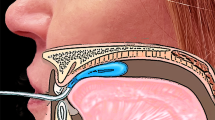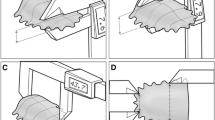Abstract
This study explored age- and sex-related differences in orofacial strength. Healthy adult men (N = 88) and women (N = 83) participated in the study. Strength measures were obtained using the Iowa Oral Performance Instrument (IOPI). Anterior and posterior tongue elevation strength measures were obtained using a standard method. Tongue protrusion and lateralization, cheek compression, and lip compression measures utilized adaptors allowing the participant to exert pressure against the bulb in different orientations. Lip and cheek strength measures were greater for men than women, but tongue strength did not differ between sex groups. Strong correlations between age and strength were not observed. However, group comparisons revealed lower tongue protrusion and lateralization strength in the oldest participants. The oldest participants also exhibited lower anterior and posterior tongue elevation strength relative to the middle-age group. Cheek and lip compression strength demonstrated no age-related differences. The current study supplements and corroborates existing literature that shows that older adults demonstrate lower tongue strength than younger adults. Sex differences were noted such that men demonstrated greater lip and cheek strength but not tongue strength. These data add to the literature on normal orofacial strength, allowing for more informed interpretations of orofacial weakness in persons with dysphagia.




Similar content being viewed by others
References
Youmans SR, Stierwalt JA. Measures of tongue function related to normal swallowing. Dysphagia. 2006;21(2):102–11.
Youmans SR, Youmans GL, Stierwalt JA. Differences in tongue strength across age and gender: is there a diminished strength reserve? Dysphagia. 2009;24(1):57–65.
Stierwalt JAG, Youmans SR. Tongue measures in individuals with normal and impaired swallowing. Am J Speech Lang Pathol. 2007;16(2):148–56.
Clark HM, Henson PA, Barber WD, Stierwalt JAG, Sherrill M. Relationships among subjective and objective measures of tongue strength and oral phase swallowing impairments. Am J Speech Lang Pathol. 2003;12:40–50.
Robbins J, Levine R, Wood J, Roecker EB, Luschei E. Age effects on lingual pressure generation as a risk factor for dysphagia. J Gerontol A Biol Sci Med Sci. 1995;50(5):M257–62.
Yoshida M, Kikutani T, Tsuga K, Utanohara Y, Hayashi R, Akagawa Y. Decreased tongue pressure reflects symptom of dysphagia. Dysphagia. 2006;21(1):61–5.
Robbins J, Gangnon RE, Theis SM, Kays SA, Hewitt AL, Hind JA. The effects of lingual exercise on swallowing in older adults. J Am Geriatr Soc. 2005;53(9):1483–9.
Robbins J, Kays SA, Gangnon RE, Hind JA, Hewitt AL, Gentry LR, Taylor AJ. The effects of lingual exercise in stroke patients with dysphagia. Arch Phys Med Rehabil. 2007;88(2):150–8.
Solomon NP, Clark HM, Makashay MJ, Newman LA. Assessment of orofacial strength in patients with dysarthria. J Med Speech Lang Pathol. 2008;16:251–8.
Clark HM, O’Brien K, Calleja A, Corrie SN. Effects of directional exercise on lingual strength. J Speech Lang Hear Res. 2009;52:1034–47.
Solomon NP, Clark HM, Makashay MJ, Newman LA. Orofacial strength and speech in normal and disordered adults. In: Conference on Motor Speech, Monterey, CA, March 2008.
Crow HC, Ship JA. Tongue strength and endurance in different aged individuals. J Gerontol A Biol Sci Med Sci. 1996;51(5):M247–50.
Lazarus C, Logemann JA, Huang CF, Rademaker AW. Effects of two types of tongue strengthening exercises in young normals. Folia Phoniatr Logop. 2003;55(4):199–205.
Dworkin JP, Aronson AE. Tongue strength and alternate motion rates in normal and dysarthric subjects. J Commun Disord. 1986;19(2):115–32.
Utanohara Y, Hayashi R, Yoshikawa M, Yoshida M, Tsuga K, Akagawa Y. Standard values of maximum tongue pressure taken using newly developed disposable tongue pressure measurement device. Dysphagia. 2008;23(3):286–90.
Clark HM, Barber WD, Irwin W. Specificity of training in the lingual musculature. In: Conference on Motor Speech, Albuquerque, NM, March 18-21, 2004.
Clark HM, Shelton N. Lingual strength & swallowing pressures after tongue or straw exercise. Philadelphia, PA: Annual Convention of the American Speech-Language-Hearing Association; 2010.
Robin DA, Goel A, Somodi LB, Luschei ES. Tongue strength and endurance: relation to highly skilled movements. J Speech Hear Res. 1992;35:1239–45.
Robin DA, Somodi LB, Luschei ES. Measurement of tongue strength and endurance in normal and articulation disordered subjects. In: Moore C, Yorkston K, Beukelman D, editors. Dysarthria and apraxia of speech: perspectives on management. Baltimore, MD: Paul H. Brooks Publishers; 1991.
Solomon NP, Munson B. The effect of jaw position on measures of tongue strength and endurance. J Speech Lang Hear Res. 2004;47(3):584–94.
Lazarus CL, Logemann JA, Pauloski BR, Rademaker AW, Larson CR, Mittal BB, Pierce M. Swallowing and tongue function following treatment for oral and oropharyngeal cancer. J Speech Lang Hear Res. 2000;43(4):1011–23.
Reddy NP, Costarella BR, Grotz RC, Canilang EP. Biomechanical measurements to characterize the oral phase of dysphagia. IEEE Trans Biomed Eng. 1990;37(4):392–7.
Acknowledgments
This project was supported in part by the American Speech-Language-Hearing Foundation and Appalachian State University Research Council. This article expresses the views of the authors, which do not necessarily reflect the official policy of the Department of the Army, Department of Defense, or US Government.
Author information
Authors and Affiliations
Corresponding author
Rights and permissions
About this article
Cite this article
Clark, H.M., Solomon, N.P. Age and Sex Differences in Orofacial Strength. Dysphagia 27, 2–9 (2012). https://doi.org/10.1007/s00455-011-9328-2
Received:
Accepted:
Published:
Issue Date:
DOI: https://doi.org/10.1007/s00455-011-9328-2




